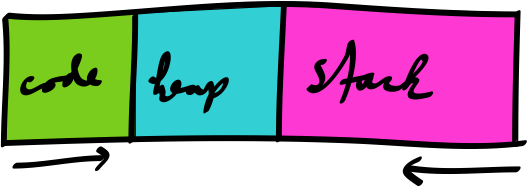Stack Machines: Jumps
fundamentals « rpn-calculator « shunting-yard « io « jumps « conditionals « comments « calls « variables « stack-frames « heap « compilers
label(start)
Hi.
We have seen that stack machines can be extended with I/O, enabling them to talk back at us pesky humans.
We shall now make a huge leap by introducing a new feature: Jumps!
jmp(main)
label(gif)

label(main)
My CPU uses GOTO?
The fundamental control flow mechanism in most virtual machines and in actual CPUs is a jump. Jumps are a matter of jumping to a particular memory address and continuing execution from there.
High-level constructs like if and while statements are compiled down to jumps.
So far, the stack machine has no control flow. Its execution is linear. The instructions are read sequentially from the instruction stream and executed in order. Once the end of the instruction stream is reached, the program terminates.
In the code, this is signified by this line:
foreach ($ops as $op) {
The foreach loop limits the execution to be linear.
Memory model
Modern computers are implemented in terms of the Von-Neumann-Architecture. In simple terms, that architecture means that programs are stored in memory. This is quite significant, as it means the instructions for what a computer should do and the data used by the program are stored in the same place!
It means you only have to build one general purpose physical machine, and have any program run on it, simply by writing it into memory. This is the reason why software is soft.
You can think of memory as a huge array of numbers. Some of the numbers represent program instructions and are often known as opcodes. Some of the numbers represent data used by the program.
In order to not mix the program space and the data space (although self-modifying code can be fun to play with), the memory is chunked up into segments.
Quite often, the segments will be: code, heap, stack.

The current stack machine already models these segments!
We have a code segment:
$ops = explode(' ', '1 2 +');
There is no heap, at least not yet. If we had dynamically allocated numbers, the heap would hold them.
But there is a stack segment:
$stack = new SplStack();
Instruction pointer
When a program is executed, there is always a current instruction that is being executed. The CPU can remember this instruction by storing its address in a register called the instruction pointer.
You can think of a register as a variable inside of the CPU. A memory address is just an offset into the large array that is memory.
The instruction pointer points into the code segment. For this reason it is sometimes also called the code pointer.

We can get the instruction pointer $ip by reading the index in the foreach loop:
foreach ($ops as $ip => $op) {
This foreach loop can also be written as a for loop:
for ($ip = 0; $ip < count($ops); $ip++) {
$op = $ops[$ip];
Or even as a while loop:
$ip = 0;
while ($ip < count($ops)) {
$op = $ops[$ip++];
There is a fundamental difference between the foreach and the while that we will discover shortly.
SPOILER ALERT (don’t tell your parents): This allows the instruction pointer to be changed.
Labels
Jumps will involve referencing addresses in the code segment. In other words, referencing the particular instruction that you want to jump to.
It would be possible to reference that instruction by its address directly. This would mean hard-coding the offset into the program. That is rather inflexible though, because every time code is shifted around, the offset needs to be adjusted manually.
A better way of getting an address is by introducing labels. A label just names a location in memory. That’s it.
So instead of referring to a memory location by address, there is a lookup table from name to address, allowing memory to be referred to by name.
The syntax I will use for labels will look like this:
label(foo)
some code
some more code
label(bar)
even more code
Jumps
To perform a jump, there needs to be a jmp instruction in the VM. That instruction takes a label name, looks up the corresponding address, then sets the instruction pointer $ip to that address.
This allows jumping backward:
label(forever)
jmp(forever)
This example loops forever.
Or forward:
label(main)
1 2 +
jmp(skip)
label(garbage)
some random garbage
label(skip)
2 +
This example skips over the garbage label, jumping to the skip label.
Pre-processing
In order to lookup labels that are defined later in the instruction stream, all labels must be pre-processed. The label table must be built ahead of time.
This is just a matter of looping over the code segment and looking for labels.
$labels = [];
foreach ($ops as $ip => $op) {
if (preg_match('/^label\((.+)\)$/', $op, $match)) {
$label = $match[1];
$labels[$label] = $ip;
}
}
We are now ready to implement the actual jump instruction.
Implementation
The jump instruction just sets the instruction pointer $ip to the address of the label.
if (preg_match('/^jmp\((.+)\)$/', $op, $match)) {
$label = $match[1];
$ip = $labels[$label];
continue;
}
Since the label definition is implemented as a pseudo-instruction, it must be handled as a noop.
if (preg_match('/^label\((.+)\)$/', $op, $match)) {
// noop
continue;
}
Unconditionally
Unconditional, unconditionally
I will love you unconditionally
There is no fear now
Let go and just be free
I will love you unconditionally— Katy Perry
This machine supports two classes of programs: Those that always terminate, and those that loop forever.

Whether or not a program contains an infinite loop can be decided statically. The halting problem is solved. We can go home now.
The reason is that jumps are unconditional. A jump will always be followed. It has exactly one entry point and one exit point.
Conditional branching will change everything once again, but for now let us enjoy the unconditional infinite loops.
Summary
Adding unconditional jumps to an RPN calculator allows it to loop forever.
fundamentals « rpn-calculator « shunting-yard « io « jumps « conditionals « comments « calls « variables « stack-frames « heap « compilers
Appendix
Here is the full code for a stack machine with pre-processed labels and non-conditional jumps:
$labels = [];
foreach ($ops as $ip => $op) {
if (preg_match('/^label\((.+)\)$/', $op, $match)) {
$label = $match[1];
$labels[$label] = $ip;
}
}
$ip = 0;
$stack = new SplStack();
while ($ip < count($ops)) {
$op = $ops[$ip++];
if (is_numeric($op)) {
$stack->push((int) $op);
continue;
}
if (preg_match('/^jmp\((.+)\)$/', $op, $match)) {
$label = $match[1];
$ip = $labels[$label];
continue;
}
if (preg_match('/^label\((.+)\)$/', $op, $match)) {
// noop
continue;
}
switch ($op) {
case '+':
$b = $stack->pop();
$a = $stack->pop();
$stack->push($a + $b);
break;
// ...
}
}
But we both know you’re only here for the gifs.
